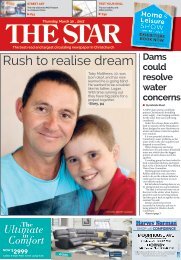Review of the Tsunami Evacuation 2017
You also want an ePaper? Increase the reach of your titles
YUMPU automatically turns print PDFs into web optimized ePapers that Google loves.
• On <strong>the</strong> instruction <strong>of</strong> <strong>the</strong> Director <strong>of</strong> CDEM or <strong>the</strong> National Controller to issue a warning or<br />
advisory, MCDEM will send <strong>the</strong> appropriate type <strong>of</strong> message by email and SMS text message<br />
to those registered with <strong>the</strong> national warning system and <strong>the</strong> news media.<br />
• With respect to tsunami events, MCDEM may issue one or more <strong>of</strong> <strong>the</strong> following notifications:<br />
o National Advisory – <strong>Tsunami</strong>: No Threat to NZ<br />
o National Advisory – <strong>Tsunami</strong>: Potential Threat to NZ<br />
o National Warning – <strong>Tsunami</strong>: Threat to NZ<br />
o National Warning – <strong>Tsunami</strong>: Marine and Beach Threat<br />
o National Warning – <strong>Tsunami</strong>: Marine and Land Threat<br />
o National Advisory – <strong>Tsunami</strong>: Cancellation Message<br />
o National Warning – <strong>Tsunami</strong>: Cancellation Message<br />
• MCDEM contact <strong>the</strong> MCDEM Regional Emergency Management Advisors to advise <strong>the</strong>m that a<br />
message has been issued and allow <strong>the</strong>m to call <strong>the</strong> relevant CDEM Groups to ensure <strong>the</strong>y<br />
have received <strong>the</strong> message.<br />
• When a “national warning message” is received from MCDEM by CDEM Groups, <strong>the</strong>y analyse<br />
<strong>the</strong> information and decide what to do in <strong>the</strong>ir region. All recipients must respond as per <strong>the</strong>ir<br />
individual emergency response procedures.<br />
• If <strong>the</strong> CDEM Group decides that a local warning is required, <strong>the</strong>n a response (i.e. evacuation) is<br />
activated.<br />
• MCDEM will follow up a national advisory message with ei<strong>the</strong>r an hourly (or more frequent)<br />
update, or a national warning, or a cancellation message. A national warning message will be<br />
followed by an hourly (or more frequent) update or a cancellation message.<br />
Distant and Regional Source <strong>Tsunami</strong> – lead agency is MCDEM<br />
As detailed in <strong>the</strong> Guide, MCDEM and GNS Science receive tsunami information statements or threat<br />
messages from <strong>the</strong> Pacific <strong>Tsunami</strong> Warning Centre (PTWC) for earthquakes equal to or higher than<br />
magnitude 6.5 in <strong>the</strong> Pacific. GNS Science is responsible for local sea level monitoring. The MCDEM<br />
Duty Officer gives immediate consideration to information received from <strong>the</strong> PTWC by applying<br />
standard criteria related to <strong>the</strong> locality, magnitude, depth <strong>of</strong> <strong>the</strong> earthquake and by consulting with<br />
GNS Science. If time permits, GNS Science will convene a panel <strong>of</strong> national tsunami experts to give ongoing<br />
advice to MCDEM as <strong>the</strong> situation develops.<br />
Depending on <strong>the</strong> assessment, a recommendation is made to <strong>the</strong> National Controller or Director <strong>of</strong><br />
CDEM and at <strong>the</strong>ir direction MCDEM issues an appropriate advisory or warning via <strong>the</strong> national<br />
warning system. CDEM Groups activate <strong>the</strong>ir respective local warning systems in response to warnings<br />
or advisories issued by MCDEM and decide on appropriate fur<strong>the</strong>r action. Decisions about local<br />
responses are encouraged to be made in consultation with neighbouring Controllers and <strong>the</strong> National<br />
Controller.<br />
Local Source <strong>Tsunami</strong> – lead agency is CDEM Group<br />
The Guide provides details on local source tsunamis and advises that <strong>the</strong> lead agency is <strong>the</strong> CDEM<br />
Group. A tsunami generated in conjunction with a local large earthquake or undersea landslide may<br />
not provide sufficient time to implement <strong>of</strong>ficial warning procedures. This is because <strong>the</strong> proximity <strong>of</strong><br />
<strong>the</strong> tsunami source and its travel speed combine to give very little time for meaningful warnings to <strong>the</strong><br />
areas closest to <strong>the</strong> source. Proper public education is <strong>the</strong>refore <strong>the</strong> principal preparedness measure<br />
for local source tsunami. The recommended public message is:<br />
8















